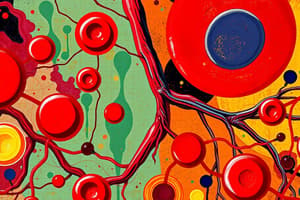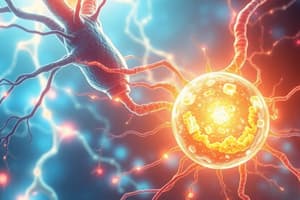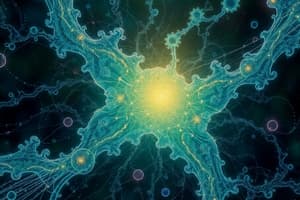Podcast
Questions and Answers
What is the main change in circuitry in the frog's circulation?
What is the main change in circuitry in the frog's circulation?
- The conversion of the sixth aortic arch into a pulmonary artery
- The separation of oxygenated and deoxygenated blood not being completed
- The elimination of gills reducing obstacles to blood flow
- The shift from gill to lung breathing (correct)
How does blood move through the frog's heart?
How does blood move through the frog's heart?
- Blood from the lung enters the left atrium
- Blood from the body enters through the sinus venosus and right atrium
- When the ventricle contracts, blood moves to the lungs or body
- Both atria contract at the same time, driving blood into the ventricle (correct)
How do adult amphibians catch prey?
How do adult amphibians catch prey?
- They use their front limbs to grab and immobilize prey
- They catch prey with a tongue that is attached at the front of the mouth (correct)
- They use a sticky secretion from their skin to trap prey
- They use their teeth to hold prey without biting or chewing
What is the function of teeth in adult amphibians?
What is the function of teeth in adult amphibians?
How does the short digestive tract of adult amphibians function?
How does the short digestive tract of adult amphibians function?
Flashcards
Frog Circulation Change
Frog Circulation Change
The transition from using gills to breathing with lungs.
Frog Heart Bloodflow
Frog Heart Bloodflow
Both atria contract together, pushing blood into the ventricle.
Amphibian Prey Capture
Amphibian Prey Capture
Using a sticky tongue attached at the front of the mouth.
Amphibian Teeth Function
Amphibian Teeth Function
Signup and view all the flashcards
Short Amphibian Gut Function
Short Amphibian Gut Function
Signup and view all the flashcards
Study Notes
Circulatory System of Frogs
- The main change in circuitry in the frog's circulation is the separation of oxygenated and deoxygenated blood, which is a key adaptation for terrestrial life.
Heart Function and Blood Flow
- Blood moves through the frog's heart in a dual circulation pathway, with oxygenated blood flowing from the lungs to the body and deoxygenated blood flowing from the body to the lungs.
Feeding Mechanisms in Adult Amphibians
- Adult amphibians, such as frogs and toads, catch prey using their sticky tongues, which are rapidly extended and retracted to capture insects and other invertebrates.
Teeth Function in Adult Amphibians
- Teeth in adult amphibians are not used for chewing or tearing food, but instead serve to grasp and hold onto prey, ensuring that it is not lost during the capture and swallowing process.
Digestive System of Adult Amphibians
- The short digestive tract of adult amphibians functions to quickly absorb nutrients from food, which is made possible by the presence of a large surface area and a high enzymatic activity.
Studying That Suits You
Use AI to generate personalized quizzes and flashcards to suit your learning preferences.




